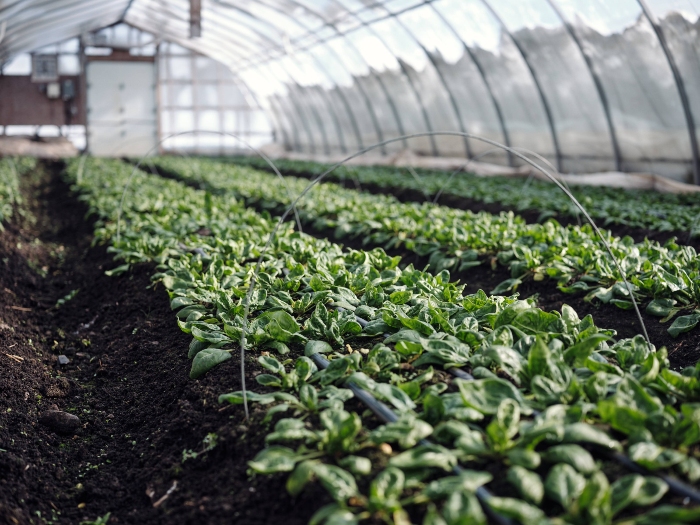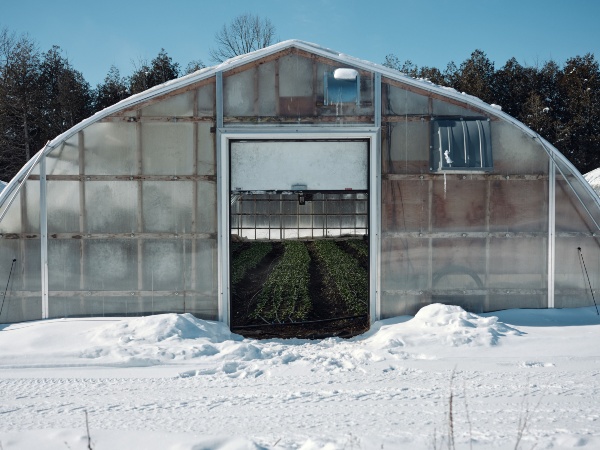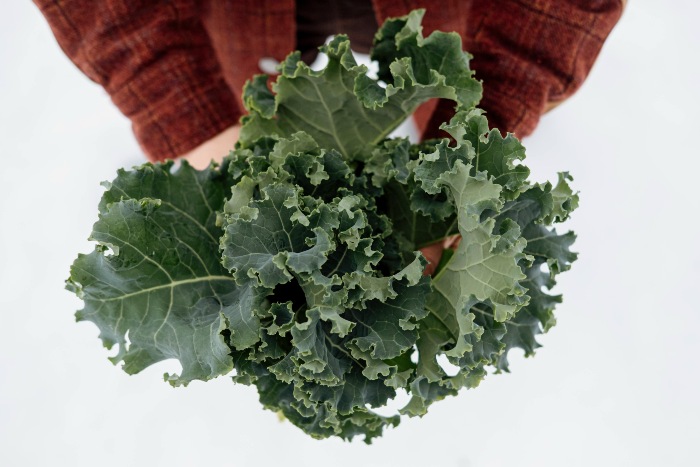When you are living in a hardiness zone that goes below 0 °C (32 °F), you know that you need to bear in mind which crops can withstand growing in your neck of the woods during the cold months. As a market gardener considering season extension, choosing frost-hardy vegetables for winter growing is essential! On our farm, we have found it easiest and best practice to classify our winter crops into three categories depending on the lowest temperature they can withstand inside the greenhouse: Low frost-hardy crops (0 °C to -4 °C or 32 °F to 25 °F), frost hardy crops (-5 °C to -10 °C or 23 °F to 14 °F) and really frost-hardy crops (-11 °C to -30 °C or 12 °F to -22 °F) By establishing which crops can endure these temperatures, we can group similar crops together and minimize how much we heat our greenhouses.
Spinach – The Hardiest of All Hardy Crops

When it comes to winter growing and hardiness, spinach is king! It’s one of the crops that actually improves in the cold, becoming sweeter and more delicious. Specifically, the Space, Auroch, and Kolibri cultivars are adapted for winter growing. When it comes to spinach, we like to grow as much as possible since it is a winter favorite. We harvest the biggest outer leaves every week, leaving the smaller leaves to grow for the following harvest. We grow the spinach on 4 rows rather than the 5 rows we have over the summer. A big challenge in no-heat greenhouses is managing the humidity and the resulting fungal problems and mildew. By having more space between each plant there is more airflow. When cultivating in winter, it is necessary to continue to be assiduous on the weeding (even if everything grows less quickly) as the air circulation is important and the spacing is wider.
Claytonia
Claytonia is one of the hardiest winter greens. And between us growers, it is one of the most lucrative because of how much it weighs! We grow it in an unheated greenhouse as it can withstand temperatures as cold as -30 °C (-22 °F). It has a nice, mild flavor and you can get up to 3 clean cuts with your trusted Opinel harvesting knife over the winter. We add it to our winter mesclun mix or sell it on its own.
Salanova Lettuce

We grow Salanova lettuce on 5 rows in the winter. It is quite hardy as long as it’s given the time to acclimatize to the cold weather. We do recommend growing it in the minimally heated greenhouse for optimal results. Due to the humidity, it is essential to make clean cuts and to keep the surrounding area free from decaying lettuce so that the Salanova doesn’t spoil. The major challenge is managing the humidity since powdery mildew is a common occurrence. You may need to consider ventilating and heating at the same time to decrease your humidity levels
Kale

Our winter growing strategy differs slightly with kale. To optimize the space in our precious minimally heated greenhouse, we grow the kale on two rows, interlaced with bok choy. Bok choy will reach maturity while the kale is slowly growing. Once the bok choy are harvested, kale plants will grow to their full size in the space left on the bed. We plant the kale in the greenhouse in mid-September and begin harvesting it in November. We strictly take the largest exterior leaves and leave the rest for the following weeks. By moderating our harvest, we can guarantee a certain number of bunches every week.
Winter Growing Is More Art than Science
Growing vegetables year-round, and especially growing them during the winter, is more of an art form than a science. To avoid a potentially costly learning curve, in both time and money, consider investing in your training. After several years of field experience, we have documented all of our winter growing knowledge in the book The Winter Market Gardening: A Successful Grower’s Handbook for Year-Round Harvests. If you operate a small vegetable farm in a northern climate and want to produce vegetables year-round, this course will help you on your journey.










